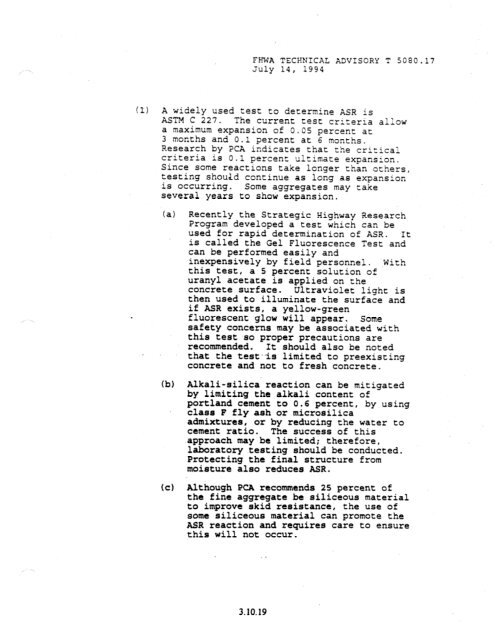chapter 3 rigid pavement - DOT On-Line Publications - Department ...
chapter 3 rigid pavement - DOT On-Line Publications - Department ...
chapter 3 rigid pavement - DOT On-Line Publications - Department ...
You also want an ePaper? Increase the reach of your titles
YUMPU automatically turns print PDFs into web optimized ePapers that Google loves.
FHwA TECHNICAL ADVISORY T 5080.17<br />
July 14, 1994<br />
(1) A widely used test to determine ASR is<br />
ASTM C 227. The current test criteria allow<br />
a maximum expansion of 0.05 percent at<br />
3 months and 0.1 percent at 6 months.<br />
Research by ?CA indicates that the critical<br />
criteria is 0.1 percent ultimate expansion.<br />
Since some reactions take longer than others,<br />
testing should continue as long as expansion<br />
is occurring. Some aggregates may take<br />
several years to show expansion.<br />
(a) Recently the Strategic Highway Research<br />
Program developed a test which can be<br />
used for rapid determination of ASR. It<br />
is called the Gel Fluorescence Test and<br />
can be performed easily and<br />
inexpensively by field personnel. With<br />
this test, a 5 percent solution of<br />
uranyl acetate is applied on the<br />
concrete surface. Ultraviolet light is<br />
then used to illuminate the surface and<br />
if ASR exists, a yellow-green<br />
. . fluorescent glow will appear. Some<br />
safety concerns may be associated with<br />
this test-so proper precautions are<br />
recommended. It should also be noted<br />
_ that the test-is limited to preexisting<br />
concrete and not to fresh concrete.<br />
(b) Alkali-silica- reaction can be mitigated<br />
by limiting the alkali content of<br />
portland cement to 0.6 percent, by using<br />
class F fly ash or microsilica<br />
admixtures, or by reducing the water to<br />
cement ratio. The success of this<br />
-approach may be limited; therefore,<br />
laboratory testing should be conducted.<br />
Protecting the final structure from<br />
moisture also reduces ASR.<br />
(c) Although PCA recommends 25 percent of<br />
the fine aggregate be siliceous material<br />
to improve skid resistance, the use of<br />
some siliceous material can promote the<br />
ASR reaction and requires care to ensure<br />
this will not occur.<br />
3.10.19
















